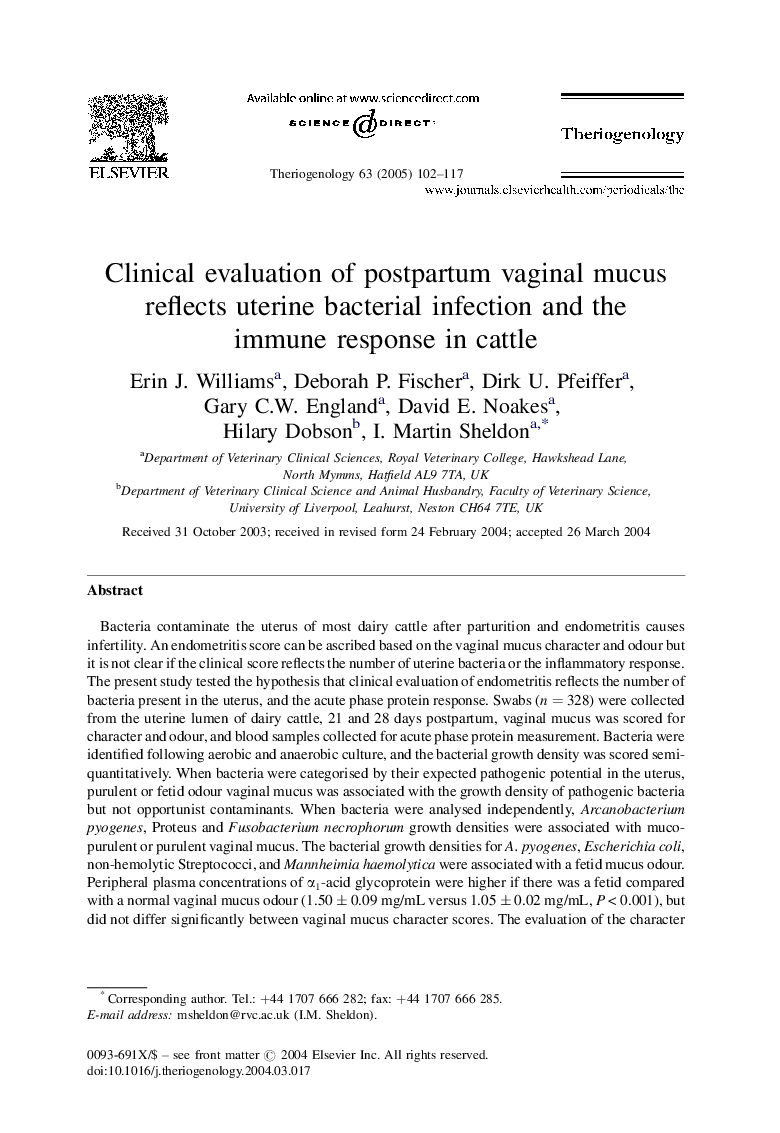| کد مقاله | کد نشریه | سال انتشار | مقاله انگلیسی | نسخه تمام متن |
|---|---|---|---|---|
| 10894624 | 1082595 | 2005 | 16 صفحه PDF | دانلود رایگان |
عنوان انگلیسی مقاله ISI
Clinical evaluation of postpartum vaginal mucus reflects uterine bacterial infection and the immune response in cattle
دانلود مقاله + سفارش ترجمه
دانلود مقاله ISI انگلیسی
رایگان برای ایرانیان
کلمات کلیدی
موضوعات مرتبط
علوم زیستی و بیوفناوری
علوم کشاورزی و بیولوژیک
علوم دامی و جانورشناسی
پیش نمایش صفحه اول مقاله

چکیده انگلیسی
Bacteria contaminate the uterus of most dairy cattle after parturition and endometritis causes infertility. An endometritis score can be ascribed based on the vaginal mucus character and odour but it is not clear if the clinical score reflects the number of uterine bacteria or the inflammatory response. The present study tested the hypothesis that clinical evaluation of endometritis reflects the number of bacteria present in the uterus, and the acute phase protein response. Swabs (n = 328) were collected from the uterine lumen of dairy cattle, 21 and 28 days postpartum, vaginal mucus was scored for character and odour, and blood samples collected for acute phase protein measurement. Bacteria were identified following aerobic and anaerobic culture, and the bacterial growth density was scored semi-quantitatively. When bacteria were categorised by their expected pathogenic potential in the uterus, purulent or fetid odour vaginal mucus was associated with the growth density of pathogenic bacteria but not opportunist contaminants. When bacteria were analysed independently, Arcanobacterium pyogenes, Proteus and Fusobacterium necrophorum growth densities were associated with mucopurulent or purulent vaginal mucus. The bacterial growth densities for A. pyogenes, Escherichia coli, non-hemolytic Streptococci, and Mannheimia haemolytica were associated with a fetid mucus odour. Peripheral plasma concentrations of α1-acid glycoprotein were higher if there was a fetid compared with a normal vaginal mucus odour (1.50 ± 0.09 mg/mL versus 1.05 ± 0.02 mg/mL, P < 0.001), but did not differ significantly between vaginal mucus character scores. The evaluation of the character and odour of vaginal mucus reflects the number of bacteria in the uterus, and the acute phase protein response.
ناشر
Database: Elsevier - ScienceDirect (ساینس دایرکت)
Journal: Theriogenology - Volume 63, Issue 1, 1 January 2005, Pages 102-117
Journal: Theriogenology - Volume 63, Issue 1, 1 January 2005, Pages 102-117
نویسندگان
Erin J. Williams, Deborah P. Fischer, Dirk U. Pfeiffer, Gary C.W. England, David E. Noakes, Hilary Dobson, I.Martin Sheldon,